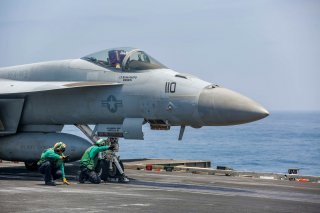China Could Soon Have the Most Powerful Type of Warship Ever
China could also be joining the exclusive club of navies with a nuclear-powered carrier.
Currently, only the United States and France operate true nuclear-powered aircraft carriers, and this includes the United States Navy's ten Nimitz-class carriers and one Gerald R. Ford-class carrier as well as the French Navy's flagship Charles de Gaulle. The warships are capable of operating for more than twenty years without refueling and have an expected service life that exceeds half a century.
Within the next decade, it is possible that the world's oceans could see at least some additional nuclear-powered carriers patrolling distant waters. The United States Navy has been exploring ways to extend the life of the Nimitz-class, while France is currently building a new nuclear-powered carrier.
More importantly, China could also be joining the exclusive club of navies with a nuclear-powered carrier.
According to a story first reported in the South China Morning Post, two sources close to the People's Liberation Army (PLA) have said that its fourth aircraft carrier, which is still under construction, would be nuclear powered.
China currently operates two aircraft carriers, one of which – the Liaoning – was a former Soviet-era carrier that was purchased from Ukraine and refurbished by the Chinese People's Liberation Army Navy (PLAN); while the other has become Beijing's first domestically-built carrier, Shandong. It is also based on the Soviet Kuznetsov-class design and features a ski jump-style deck.
A third carrier is now under construction, but the project has been slow going as Beijing has had to address a slew of technical problems that delayed the progress for two years.
None of those first three carriers is nuclear-powered; however, it appears that the next warship could be.
"Shipbuilders and ship propulsion engineers are keen on making a significant breakthrough with the construction of the fourth carrier," the source, who is reported to be close to the Chinese Navy, told the Chinese news outlet on condition of anonymity. "It will be a technological leap for the shipbuilding industry … but construction may take longer than for its sister ship due to the different propulsion systems."
A second source, who also asked not to be identified, told the South China Morning Post that the Central Military Commission has been studying a proposal from the China State Shipbuilding Corporation (CSSC) to determine the feasibility of utilizing nuclear power for the fourth carrier.
This isn't exactly ground-breaking news, however. The CSSC had reported in February 2018 that it was developing a nuclear-powered aircraft carrier. Such an effort could allow the PLAN to become a true "blue water" navy, and be able to operate in deep waters and open oceans by 2025. The PLAN has announced a goal of operating at least six aircraft carrier strike groups by 2035 to match the naval strength of the United States Navy in the Pacific.
In 2018, China General Nuclear Power Group had even invited bids for a contract to construct a 30,000-tonne nuclear-powered warship. That vessel would serve as an "experimental platform" for future PLAN carrier designs.
While the carrier efforts are in the early stages, the PLAN currently operates more than a dozen nuclear-powered submarines, including the Type 091, Type 093 and Type 095.
Peter Suciu is a Michigan-based writer who has contributed to more than four dozen magazines, newspapers and websites. He regularly writes about military small arms, and is the author of several books on military headgear including A Gallery of Military Headdress, which is available on Amazon.com.

